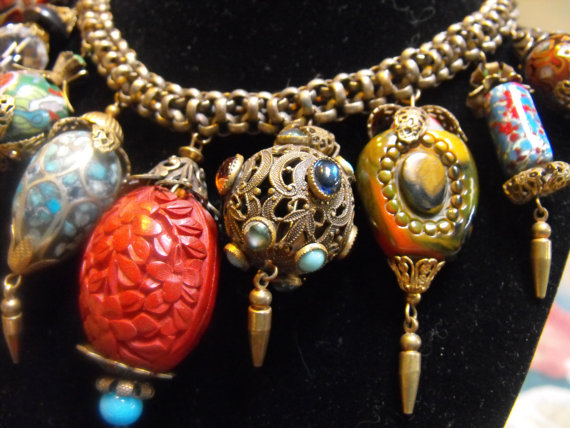Helen Burton was proprietor of The Camel Bell gift shop in
the Peking Hotel during the 1920s-30s, and a notable prisoner of the Weihsien
internment camp during the early years of World War II. Donald Menzies (now sadly passed) wrote an informative biography of Helen, which includes a Life magazine photo of her wearing a 30s-style necklace and
dramatic bracelets. The photo was taken
during a sad occasion; nonetheless, Helen is neat and stylish despite having
just been released from two years of prison camp and recovering from pneumonia. A remarkable woman.
A possible example of the type of jewelry Helen sold at The
Camel Bell and its auxiliary shop on the passenger ship Empress of Britain was featured on eBay, and is of interest because
it still had the original box with a Camel Bell label.
Note the use of carved blue glass beads and drops typical of
those used for Qing court necklaces.
In my quest to find pre-World War II Chinese cloisonné
dragon beads, I encountered two specimens of an interesting brass belt:
 |
| Sold by MagicDragonsStore on Etsy |
 |
| Note the two different styles of dragon/phoenix beads |
The floral and dragon bead patterns can be found in other
late 1930s-early 1940s costume jewelry, as explored in previous posts on MiriamHaskell and Louis C. Mark. However, upon
examination with a loupe, there are two striking anomalies about the large
disk-shaped dragon/phoenix beads:
 |
| Beads in the belt in my possession |
1) They are not wired cloisonné. That is, unlike the other beads, the cloisons
are not formed by thin strips of copper wire; instead, the cloisons are all
perfectly identical, and are specimens of the champlevé technique. I have no idea how the designs were
reproduced – stamping from a die seems most likely, as this technique shows up
in other Chinese cloisonné right up the present. In other words, the design was not outlined
by thin copper strips, but instead stamped or etched; the only difference from
one bead to another is the colors of enamels that were subsequently painted
into the design holes and background.
Here is a little bracelet featuring
champlevé bells – note how the interior view shows what seems to be a stamped
pattern [possibly Thai?].
 |
| eBay vendor didirdh |
And here is a more recently manufactured
small round box offered by eBay vendor liwz88 that shows the technique very
clearly. Because of the transparent enamels, I suppose this particular piece could also be called basse-taille - but the point remains that the cloisons were formed mechanically, not by hand, and can be exactly reproduced from one piece to the next.
2) The dragons are not drawn in the stereotypical
style that shows up in the other beads, as described in a prior post.
Here’s a similar dragon design offered by
eBay vendor, featuring transparent enamels reminiscent of the Canton enamel
technique. Interestingly, this piece is
listed as a Japanese obidome.
 |
| courtesy of eBay vendor the-original-crazy-lady-antiques |
A large Haskell-style brooch featuring these champleve beads:
This necklace also features old court necklace-style cut glass beads, a large disc-shaped cloisonne pendant, brass chain and other assorted Chinese stone charms:
And recently on eBay, a silver brooch featuring this champlevé dragon design in a round brocade-covered cotton-filled box that appears to be similar in style to the Camel Bell box that accompanied the blue glass beads necklace and earrings.
And recently on eBay, a silver brooch featuring this champlevé dragon design in a round brocade-covered cotton-filled box that appears to be similar in style to the Camel Bell box that accompanied the blue glass beads necklace and earrings.
 |
| courtesy of mymomsantiqueshop |
In the biography by Don Menzies cited above, in a letter Helen says that she sent a shipment from her shop to Rhode Island in 1937, just prior to the Japanese invasion of China. A possible origin for these cloisonne beads, belts, and other jewelry?



















.jpg)





























































